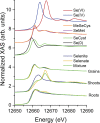Direct and indirect selenium speciation in biofortified wheat: A tale of two techniques
- PMID: 36538026
- PMCID: PMC10107779
- DOI: 10.1111/ppl.13843
Direct and indirect selenium speciation in biofortified wheat: A tale of two techniques
Abstract
Wheat can be biofortified with different inorganic selenium (Se) forms, selenite or selenate. The choice of Se source influences the physiological response of the plant and the Se metabolites produced. We looked at selenium uptake, distribution and metabolization in wheat exposed to selenite, selenate and a 1:1 molar mixture of both to determine the impact of each treatment on the Se speciation in roots, shoots, and grains. To achieve a comprehensive quantification of the Se species, the complementarity of high-performance liquid chromatography coupled with inductively coupled plasma mass spectrometry and X-ray absorption spectroscopy was exploited. This approach allowed the identification of the six main selenium species: selenomethionine, selenocysteine, selenocystine, selenite, selenate, and elemental selenium. The three treatments resulted in similar total selenium concentration in grains, 90-150 mg Se kg-1 , but produced different effects in the plant. Selenite enhanced root accumulation (66% of selenium) and induced the maximum toxicity, whereas selenate favored shoot translocation (46%). With the 1:1 mixture, selenium was distributed along the plant generating lower toxicity. Although all conditions resulted in >92% of organic selenium in the grain, selenate produced mainly C-Se-C forms, such as selenomethionine, while selenite (alone or in the mixture) enhanced the production of C-Se-Se-C forms, such as selenocystine, modifying the selenoamino acid composition. These results provide a better understanding of the metabolization of selenium species which is key to minimize plant toxicity and any concomitant effect that may arise due to Se-biofortification.
© 2022 The Authors. Physiologia Plantarum published by John Wiley & Sons Ltd on behalf of Scandinavian Plant Physiology Society.
Figures






References
-
- Aborode, F.A. , Raab, A. , Foster, S. , Lombi, E. , Maher, W. , Krupp, E.M. et al. (2015) Selenopeptides and elemental selenium in Thunbergia alata after exposure to selenite: quantification method for elemental selenium. Metallomics, 7, 1056–1066. - PubMed
-
- Alfthan, G. , Eurola, M. , Ekholm, P. , Venäläinen, E.‐R. , Root, T. , Korkalainen, K. et al. (2015) Effects of nationwide addition of selenium to fertilizers on foods, and animal and human health in Finland: from deficiency to optimal selenium status of the population. Journal of Trace Elements in Medicine and Biology, 31, 142–147. - PubMed
-
- Aureli, F. , Ouerdane, L. , Bierla, K. , Szpunar, J. , Prakash, N.T. & Cubadda, F. (2012) Identification of selenosugars and other low‐molecular weight selenium metabolites in high‐selenium cereal crops. Metallomics, 4, 968–978. - PubMed
-
- Bañuelos, G.S. , Freeman, J.L. & Arroyo, I.S. (2022) Selenium content and speciation differences in selenium enriched soups made from selenium biofortified plants. Journal of Food Composition and Analysis, 105, 104255.
-
- Boldrin, P.F. , de Figueiredo, M.A. , Yang, Y. , Luo, H. , Giri, S. , Hart, J.J. et al. (2016) Selenium promotes sulfur accumulation and plant growth in wheat (Triticum aestivum). Physiologia Plantarum, 158, 80–91. - PubMed
MeSH terms
Substances
Grants and funding
- 201608330235/China Scholarship Council
- 25-01-967/European Synchrotron Radiation Facility (at BM25A SpLine)
- 665919/H2020 Marie Skłodowska-Curie Actions (European Union)
- BES-2013-066639/Ministerio de Economía y Competitividad (MINECO, Spain)
- CTM2015-65414-C2-1-R(CHEMNEXUS)/Ministerio de Economía y Competitividad (MINECO, Spain)
LinkOut - more resources
Full Text Sources

